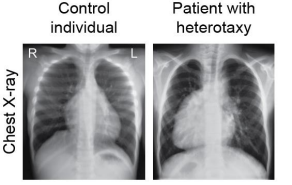Scientists discover and name novel gene that governs left-right asymmetry within the human body
14 December 2021 | Tuesday | News

Chest X-ray of a control individual (left), with his heart pointing to the left (L), while the chest X-ray of a patient with heterotaxy (right) revealed that his heart is inversely positioned pointing instead to the right (R).
A team of researchers, led by the Agency for Science, Technology and Research’s (A*STAR) Genome Institute of Singapore (GIS), in collaboration with A*STAR’s Institute of Molecular and Cell Biology (IMCB) and Bioinformatics Institute (BII), and clinicians from six different countries, has discovered a novel gene, Ciliated Left-Right Organizer Metallopeptidase (CIROP), that is crucial for establishing proper left-right asymmetry during vertebrate embryonic development. Babies that carry mutations in CIROP had internal organs randomly positioned, leading to severe birth defects consistent with heterotaxy
At first glance, the human body looks symmetrical because our left side appears to be a mirror image of the right side. This symmetry is in fact only skin-deep since our internal organs are asymmetrically placed – the heart and spleen are on the left side while the liver is on the right side of our body. This is governed by a set of genes – comprising CIROP, PKD1L1, MMP21, DAND5 and C1orf127 – which act early during embryonic development to assign each organ a stereotypical position. When this is not achieved properly, babies can be born with birth anomalies such as congenital heart defects and misplacement of internal organs along the left-right axis. On average, these diseases occur once every 10,000 births and are grouped under syndromes of heterotaxy.
By performing an evolutionary analysis of genomes from many vertebrate species, CIROP, PKD1L1, MMP21, DAND5 and C1orf127 were found to be present in ancestral animals such as fish and frogs, but absent in reptiles, birds, and certain mammals such as cetaceans. This pattern of gene disappearance during evolution correlates with the loss of motile cilia in the transient organ that establishes left-right patterning during embryogenesis.
Prof Bruno Reversade, Senior Group Leader of the Laboratory of Human Genetics and Therapeutics at GIS and IMCB, said, “Our phylogenetic screen for genes that have disappeared in vertebrate species yielded important evolutionary insights into the development of left-right patterning. Our findings suggest that these five genes have only one function, which is to distinguish left from right. Active during a small window in the course of development, these genes may never be used again after birth.”
Dr Emmanuelle Szenker-Ravi, Research Scientist from the Laboratory of Human Genetics and Therapeutics at GIS, and first author of this study, was struck that CIROP, which is such an essential gene, had never been characterised before, “CIROP’s incomplete annotation in the human genome prevented it from being used for diagnostic purposes via exome sequencing. We are thrilled that this is now remedied and will immediately benefit affected families.”
Prof Patrick Tan, Executive Director of GIS, said, “The study illustrates the power of Mendelian genetics2 which assigns gene functions and provides indisputable causality. Birth defects due to genetic mutations have devastating impact on both the children and their families. These findings will serve as the basis for research on potential therapies.”
Most Read
- Top 25 Biotech & Biopharma Leaders in Sustainable Innovation, 2025
- China’s Biopharma Dealmaking Surges in H1 2025, Driven by Record Licensing and Oncology Focus
- Chikungunya in China: How a “Forgotten” Arbovirus Found the Perfect Storm
- How Innovation Gaps in Biopharma Raise New Safety Concerns
- Smart Implants and the Future of Musculoskeletal Injury Treatment
- How Ethical Gaps in Psychiatry Could Undermine Biopharma Progress
- The Evolving Landscape of Women’s Health Innovation in the Asia-Pacific
- Using NLP-Driven Decision Support in Emergency Health Assistance
- Taiwan Steps Into the Global Spotlight With a New Cancer Therapy
- The Role of Unique Device Identification (UDI) in Tracing Medical Device Safety
- The Importance of a Patient’s Mental Health During Clinical Trials
Bio Jobs
- The State of Biotech and Life Science Jobs in Asia Pacific – 2025
- Avantor’s New CEO Ligner Aims to Unlock Global Potential and Deliver Shareholder Value
- AstraZeneca Commits $50 Billion to U.S. Expansion by 2030 in Biggest-Ever Global Investment
- Thermo Fisher, SAMRC, and South Africa’s Department of Science and Innovation Launch CATIR to Nurture Next-Gen Scientists
- Cube Biotech Appoints Former Sartorius CEO Dr. Joachim Kreuzburg to Board of Directors
- FDA’s AI Transition Marks a Turning Point in Drug Review: Industry Faces Pressure to Adapt Amid 20% Workforce Cut
- WuXi XDC Completes Mechanical Build of Singapore Bioconjugate Manufacturing Hub
News
Editor Picks











